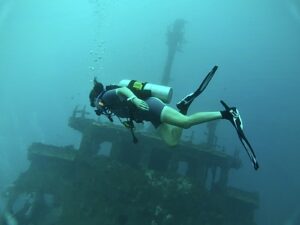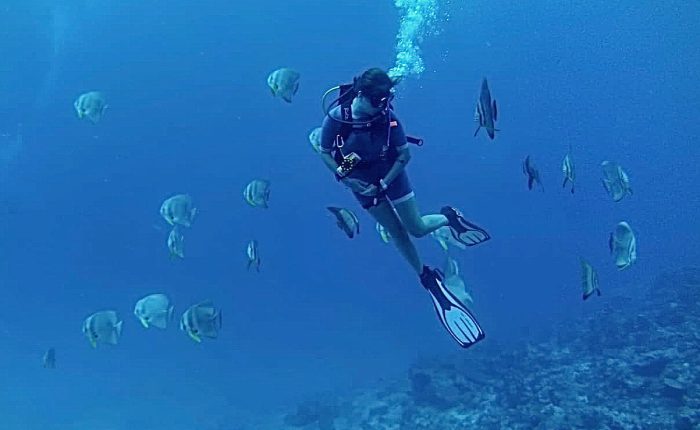When to go?
The best time to visit the Maldives is between November and April. Expect low humidity, little rain, and clear blue skies. From May to October is the wet season. October is also the Maldives’ wettest month, with high humidity and full days of rain. The average temperature stays between 25 and 30 degrees Celsius all year round and only drops a few degrees at night. We visited in October, and the rain was mostly in the afternoon and overnight. The rain didn’t affect our stay, except for one morning, when we woke up to a big thunderstorm.
We were staying in an overwater bungalow, and the whole bungalow was shaking due to the heavy wind and waves. There was also a little flood inside the bathroom and around the terrace doors. After cleaning the water, we hopped on our bikes and biked to a dive shop. The divemaster saw us and immediately shook his head, saying, there will be no diving today. We weren’t too upset, because we felt a bit lazy and, to be honest, didn’t really want to go diving. The storm was gone in two hours, and we enjoyed the rest of the day sunbathing, swimming, and drinking beers.


When is the best season for diving in the Maldives?
There isn’t a bad time of the year to dive in the Maldives. We were staying in the Sun Island Resort & Spa, which is in South Ari Atoll and is also known as the best place to snorkel or dive with a Whale Shark all year round. We did 14 dives and were lucky enough to see the Whale Shark twice. Unfortunately, it is not the same when it comes to mantas. Manta rays are present from November to April. Even though we haven’t spotted one single manta, there was a lot of other marine life. Besides the Whale Shark, we saw: Moray eels, Sting Rays, Lionfish, a big school of Batfish, Scorpionfish, Napoleon Wrasse, turtles, Black and White Tipped Reef Sharks, Grey Shark, and lots more… Not bad diving at all. The visibility was also fine.
What about dive sites?
Whale Sharks regularly patrol the water around Sun Island. These gentle giants are sometimes seen also around the house reef, which is rare but fantastic. We were lucky enough to see it on the two dive sites. The first one was Kudadhoo Corner (no 14). I will say it was my favorite dive spot, just because it made my dream come true – to dive with the biggest fish in the world. In Kudadhoo corner is also possible to spot Grey Sharks, Napoleon Wrasse, and Groupers.
The second time we saw a Whale Shark was at Ari Beach Beyru (no 17), which is also known for Pilot Whales and Sting Rays.
Another famous dive site is Hurolhi Kandu (no 61). I remember it only by a crazy strong current, Scorpionfish, and the biggest Lionfish I have ever seen, swimming only 10 cm under my buddy.
Bodufinolhu Thila (no 5) didn’t offer so many big animals, but there was a large and curious school of Batfish. They were following us, and one of them was all the time interacting with me and swimming close to my face. When I felt it too close, I just started to blow some bubbles, and it got scared and swam a bit further away. The reason the little beauty had stuck around for so long was her food caught in my hair. It got its snack from me and soon after swam away. So much about fish love.
A very nice dive site is also MV. Kudhimaa Wreck (no 52). It is an easy wreck dive, at a depth between 20 to 25 meters. The Kudhimaa was a Japanese cargo ship, which was purposely sunk in 1999. No wreck diving certificate is needed since it is just a surface dive, full of marine life. On the wreck, we also spotted a huge Giant Moray. It was gorgeous and the biggest I saw by now.
Sun Island Resort & Spa has its own dive center – diveOceanus. The staff is extremely hard working and do their best to make the dive sites diverse and unforgettable. They also offer free nitrox for certified divers and different packages.
Here is our video that summarizes all written above. Enjoy!
